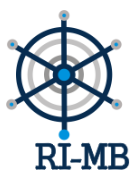
Use este identificador para citar ou linkar para este item:
https://www.repositorio.mar.mil.br/handle/ripcmb/844551Registro completo de metadados
| Campo DC | Valor | Idioma |
|---|---|---|
| dc.contributor.author | Campbell, Daniel | - |
| dc.contributor.author | Xavier, Fabio Contrera | - |
| dc.contributor.author | Melo Junior, Ubirajara Gonçalves | - |
| dc.contributor.author | Fagundes Netto, Eduardo Barros | - |
| dc.contributor.author | Biofouling, Benthic Ecology and Marine Biotechnology Meeting, 013., 2019, Arraial do Cabo (RJ) | - |
| dc.date.accessioned | 2020-03-28T18:59:10Z | - |
| dc.date.available | 2020-03-28T18:59:10Z | - |
| dc.date.issued | 2019 | - |
| dc.identifier.uri | http://www.repositorio.mar.mil.br/handle/ripcmb/844551 | - |
| dc.description.abstract | Marine soundscape is composed by all sounds from certain marine environment. Itcan be split into biophony (biotic activities), geophony (abiotic activities) andanthrophony (human activities). Nowadays, soundscape characteristics areconsidered a great information source for ocean and coastal management. Forexample, just analyzing draw soundscape data is possible makes decision aboutbetter period of year for seismic activities. However, many anthropogenic soundshave seasonal and temporal patterns that can influence marine organisms, ascetaceans, fish and some invertebrates. This study aims to investigate the seasonalinfluence of nautical tourism in marine soundscape off Cabo Frio Island, Arraial doCabo, RJ, Brazil. Acoustic data were recorded from February 2018 to January 2019with duty cycle of 20 (12 minutes per hour). Frequency range (0.1–1.5 kHz) was selected because it is more influenced by anthropogenic noise. In addition, were recorded information about nautical tourism (as boats and people number per day at Cabo Frio Island). It was recorded approximately 296 days, totaling circa 7 thousand hours. For frequency range analyzed, average power was of ∼ 71 dB with ∼ 4.2 dB of standard deviation, minimum of ∼ 53 dB and maximum of ~ 105 dB. It was confirmed that holidays, weekends and high season are more noisy than other period of year. We noted a daily pattern, where average power increases near to twilight (after dawn and dusk), probably, associated to fish chorus. Soundscape pattern recorded in this frequency range at daytime corresponded to periods of intense touristic and fishing activities in the Cabo Frio region. This anthropogenic noise represents a potential risk and could interfere in biological activities. Considering the advance of researches related to soundscape ecology, it will be possible to develop better environmental management policies for the maintenance of the natural characteristics of the study area. | pt_BR |
| dc.language.iso | eng | pt_BR |
| dc.publisher | Instituto de Estudos do Mar Almirante Paulo Moreira (IEAPM) | pt_BR |
| dc.rights | openAccess | pt_BR |
| dc.subject | Acústica Submarina | pt_BR |
| dc.title | Seasonal influence of nautical tourism in marine soundscape off Cabo Frio Island | pt_BR |
| dc.type | journalArticle | pt_BR |
| dc.location.country | Brasil | pt_BR |
| dc.subject.dgpm | Ciência, Tecnologia e Inovação | - |
| Aparece nas coleções: | Ciência, Tecnologia e Inovação: Coleção de Artigos | |
Arquivos associados a este item:
| Arquivo | Descrição | Tamanho | Formato | |
|---|---|---|---|---|
| Fagundes Netto, E. et al_BIOINC2019_seasonal influence of nautical tourism....pdf | 426,2 kB | Adobe PDF |  Visualizar/Abrir |
Os itens no repositório estão protegidos por copyright, com todos os direitos reservados, salvo quando é indicado o contrário.